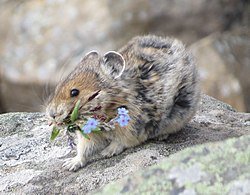| Common name | Scientific name and subspecies | Range | Size and ecology | IUCN status and estimated population |
|---|
| Afghan pika 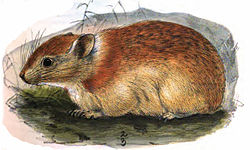 | O. rufescens
(Gray, 1842)
- O. r. regina
- O. r. rufescens
- O. r. shukurovoi
| Central Asia
 | Size: 15–24 cm (6–9 in) long [3]
Habitat: Forest, shrubland, and desert [4]
Diet: Herbs and shrubs [4] | LC
Unknown  [4] [4]
|
|---|
| Alpine pika 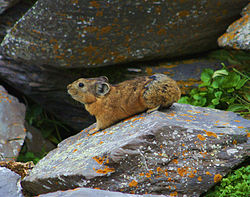 | O. alpina
(Pallas, 1773)
- O. a. alpina
- O. a. changaica
- O. a. cinereofusca
- O. a. sushkini
| Northeastern Asia
 | Size: 15–26 cm (6–10 in) long [5]
Habitat: Rocky areas [6]
Diet: Variety of plants [6] | LC
Unknown  [6] [6]
|
|---|
| American pika  | O. princeps
(Richardson, 1828)
- O. p. figginsi
- O. p. princeps
- O. p. saxatilis
- O. p. schisticeps
- O. p. taylori
| Western North America
 | Size: 15–22 cm (6–9 in) long [7]
Habitat: Rocky areas [8]
Diet: Sedges, grass, forbs, and shrubs [7] | LC
Unknown  [8] [8]
|
|---|
| Chinese red pika 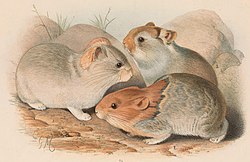 | O. erythrotis
(Büchner, 1890) | Central China
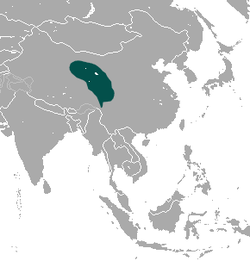 | Size: 18–19 cm (7–7 in) long [9]
Habitat: Rocky areas [10]
Diet: Variety of plants [10] | LC
Unknown  [10] [10]
|
|---|
| Collared pika  | O. collaris
(Nelson, 1893) | Northwestern North America
 | Size: 14–21 cm (6–8 in) long [11]
Habitat: Rocky areas [12]
Diet: Variety of plants, as well as bird brains [12] | LC
Unknown  [12] [12]
|
|---|
| Daurian pika 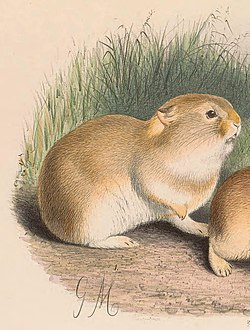 | O. dauurica
(Pallas, 1776)
- O. d. annectens
- O. d. bedfordi
- O. d. dauurica
- O. d. mursavi
| Northeastern Asia
 | Size: 17–22 cm (7–9 in) long [13]
Habitat: Grassland [14]
Diet: Shrubs, grass, legumes, and flowers [13] | LC
Unknown  [14] [14]
|
|---|
| Forrest's pika
| O. forresti
Thomas, 1923 | Southeastern Asia
 | Size: 15–19 cm (6–7 in) long [15]
Habitat: Forest and shrubland [16]
Diet: Variety of plants [16] | LC
Unknown  [16] [16]
|
|---|
| Gansu pika 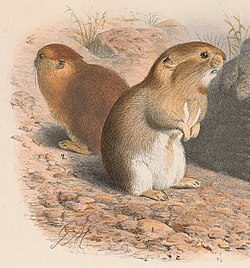 | O. cansus
Lyon, 1907
- O. c. cansus
- O. c. morosa
- O. c. sorella
- O. c. stevensi
| Central China
 | Size: 11–17 cm (4–7 in) long [17]
Habitat: Shrubland and grassland [18]
Diet: Shrubs and other plants [18] | LC
Unknown  [18] [18]
|
|---|
| Glover's pika
| O. gloveri
Thomas, 1922
- O. g. brookei
- O. g. calloceps
- O. g. gloveri
| Central China
 | Size: 16–25 cm (6–10 in) long [19]
Habitat: Rocky areas [20]
Diet: Forbs, sedge, and grass [19] | LC
Unknown  [20] [20]
|
|---|
| Helan Shan pika
| O. argentata
Howell, 1928 | Central China
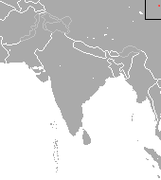 | Size: 20–24 cm (8–9 in) long [21]
Habitat: Rocky areas [22]
Diet: Variety of plants [22] | EN
Unknown  [22] [22]
|
|---|
| Hoffmann's pika
| O. hoffmanni
Formozov, Yakhontov, Dmitriev, 1996 | Northern Mongolia
 | Size: 19–21 cm (7–8 in) long [23]
Habitat: Rocky areas [24]
Diet: Variety of plants [23] | EN
Unknown  [24] [24]
|
|---|
| Ili pika
| O. iliensis
Li, Ma, 1986 | Western China
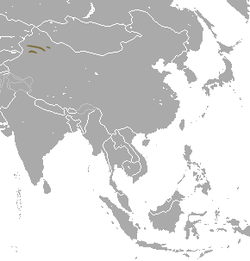 | Size: 20–21 cm (8–8 in) long [25]
Habitat: Rocky areas [26]
Diet: Herbs and shrubs [25] | EN
Unknown  [26] [26]
|
|---|
| Kazakh pika
| O. opaca
Argiropulo, 1930 | Central Asia
 | Size: 17–22 cm (7–9 in) long [27]
Habitat: Grassland and rocky areas [28]
Diet: Shrubs, herbs, and grass [27] | LC
Unknown  [28] [28]
|
|---|
| Korean pika
| O. coreana
Allen, Andrews, 1913 | North Korea and southeastern China
 | Size: 16–21 cm (6–8 in) long [29]
Habitat: Rocky areas [30]
Diet: Herbs, shrubs, forbs, fungi, berries, seeds, and lichen [30] | DD
Unknown  [30] [30]
|
|---|
| Koslov's pika  | O. koslowi
(Büchner, 1894) | Western China
 | Size: 22–24 cm (9–9 in) long [31]
Habitat: Grassland [32]
Diet: Sedges and other plants [31] | EN
Unknown  [32] [32]
|
|---|
| Ladak pika  | O. ladacensis
(Günther, 1875) | Western China and northern India and Pakistan
 | Size: 18–25 cm (7–10 in) long [33]
Habitat: Grassland [34]
Diet: Shrubs, flowers, and roots [33] | LC
Unknown  [34] [34]
|
|---|
| Large-eared pika  | O. macrotis
(Günther, 1875)
- O. m. auritus
- O. m. chinensis
- O. m. macrotis
- O. m. sacana
- O. m. wollastoni
| Central Asia and central China
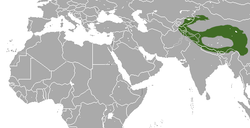 | Size: 15–20 cm (6–8 in) long [35]
Habitat: Rocky areas [36]
Diet: Grass, legumes, sedges, herbs, berries, twigs, moss, and lichen [37] | LC
Unknown  [36] [36]
|
|---|
| Manchurian pika  | O. mantchurica
Thomas, 1909 | Northeastern China
 | Size: 13–22 cm (5–9 in) long [38]
Habitat: Forest, shrubland, and rocky areas [39]
Diet: Variety of plants [38] | LC
Unknown  [39] [39]
|
|---|
| Moupin pika
| O. thibetana
(Milne-Edwards, 1871)
- O. t. nangqenica
- O. t. osgoodi
- O. t. sacraria (Sacred pika)
- O. t. sikimaria (Sikkim pika)
- O. t. thibetana
| Central China
 | Size: 14–18 cm (6–7 in) long [40]
Habitat: Forest and shrubland [41]
Diet: Variety of plants [41] | LC
Unknown  [41] [41]
|
|---|
| Northern pika  | O. hyperborea
(Pallas, 1811)
- O. h. cinereoflava
- O. h. ferruginea
- O. h. hyperborea
- O. h. normalis
- O. h. uralensis
- O. h. yesoensis
- O. h. yoshikurai
| Northeastern Asia
 | Size: 13–29 cm (5–11 in) long [42]
Habitat: Forest, shrubland, and rocky areas [43]
Diet: Herbs, shrubs, forbs, fungi, berries, seeds, and lichen [42] | LC
Unknown  [43] [43]
|
|---|
| Nubra pika
| O. nubrica
Thomas, 1922
- O. n. lhasaensis
- O. n. nubrica
| South Asia
 | Size: 14–19 cm (6–7 in) long [44]
Habitat: Shrubland and grassland [45]
Diet: Variety of plants [44] | LC
Unknown  [45] [45]
|
|---|
| Pallas's pika 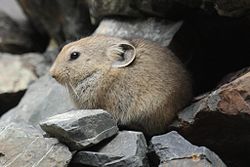 | O. pallasi
(Gray, 1867)
- O. p. hamica
- O. p. pallasi
- O. p. pricei
- O. p. sunidica
| Central and Eastern Asia
 | Size: 19–23 cm (7–9 in) long [46]
Habitat: Grassland and rocky areas [47]
Diet: Grass and herbs [48] | LC
Unknown  [47] [47]
|
|---|
| Plateau pika  | O. curzoniae
(Hodgson, 1858) | Western China and Northern India
 | Size: 16–21 cm (6–8 in) long [29]
Habitat: Grassland and desert [49]
Diet: Variety of plants [49] | LC
Unknown  [49] [49]
|
|---|
| Royle's pika  | O. roylei
(Ogilby, 1839)
- O. r. himalayana (Himalayan pika)
- O. r. nepalensis
- O. r. roylei
- O. r. wardi
| Western China and Northern India
 | Size: 13–21 cm (5–8 in) long [50]
Habitat: Rocky areas [51]
Diet: Forbs, as well as other plants [50] | LC
Unknown  [51] [51]
|
|---|
| Steppe pika  | O. pusilla
(Pallas, 1769)
- O. p. angustifrons
- O. p. pusilla
| Central Asia
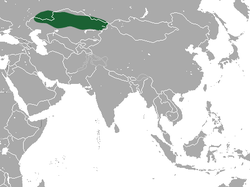 | Size: 15–21 cm (6–8 in) long [52]
Habitat: Shrubland and grassland [53]
Diet: Grass and above-ground vegetation [52] | LC
Unknown  [53] [53]
|
|---|
| Thomas's pika
| O. thomasi
Argiropulo, 1948 | Central China
 | Size: 13–16 cm (5–6 in) long [54]
Habitat: Shrubland and grassland [55]
Diet: Variety of plants [55] | LC
Unknown  [55] [55]
|
|---|
| Tsing-ling pika
| O. syrinx
Matschie, 1908 | Central China
 | Size: 13–18 cm (5–7 in) long [56]
Habitat: Forest and shrubland [57]
Diet: Variety of plants [57] | LC
Unknown  [57] [57]
|
|---|
| Turkestan red pika 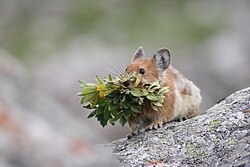 | O. rutila
(Sévertsov, 1873) | Central Asia
 | Size: 18–26 cm (7–10 in) long [58]
Habitat: Rocky areas [59]
Diet: Grass and other plants [59] | LC
Unknown  [59] [59]
|
|---|
| Turuchan pika  | O. turuchanensis
Naumov, 1934 | Central Russia
 | Size: 15–22 cm (6–9 in) long [60]
Habitat: Rocky areas [61]
Diet: Variety of plants [61] | LC
Unknown  [61] [61]
|
|---|
